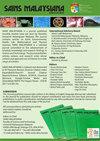黄芩提取物对高脂饮食诱导的高脂血症大鼠的降血脂和肝保护作用:抗氧化活性的作用
IF 0.8
4区 综合性期刊
Q3 MULTIDISCIPLINARY SCIENCES
引用次数: 0
摘要
高脂血症和氧化应激是心血管疾病发病的主要危险因素,而高血脂引起的氧化应激可导致肝损伤。据报道,桂圆含有较高的抗氧化剂,可提供治疗优势。本研究旨在评估桂圆根茎提取物(ZCRE)在高脂饮食(HFD)诱导的高脂血症大鼠模型中的抗高脂血症和保肝作用,并通过其对内源性抗氧化酶的影响研究其机制。本研究采用96%(v/v)乙醇萃取决明子根茎,蒸干后得到浓缩决明子根茎提取物(ZCRE)。采用薄层色谱法(TLC)-密度计测定提取物中的姜黄素含量。采用高脂饮食诱导的高脂血症模型来评估 ZCRE 在大鼠中的抗高脂血症和保肝活性。雄性 Wistar 大鼠被随机分为五组:正常对照组;高脂饮食诱发高脂血症大鼠组(HFD);高脂饮食和 100 mg/kgBW ZCRE 大鼠组(HFD + 100 mg/kgBW);高脂饮食和 200 mg/kgBW ZCRE 大鼠组(HFD + 200 mg/kgBW);高脂饮食和 400 mg/kgBW ZCRE 大鼠组(HFD + 400 mg/kgBW)。通过对体重、血液生化指标(包括总胆固醇(TC)、甘油三酯(TG)、血清谷草转氨酶(SGOT)和血清谷丙转氨酶(SGPT))进行一系列分析,评估了 ZCRE 的降血脂和保肝潜力。对肝脏匀浆中过氧化氢酶(CAT)和谷胱甘肽过氧化物酶(GSH-Px)的抗氧化活性进行了评估。研究数据以平均值 ± SD 表示,并采用单因素方差分析(ANOVA)进行分析,然后用最小显著差异(LSD)检验进行多重比较。TLC 分析表明,ZCRE 含有大量姜黄素。此外,研究还表明,与高脂血症大鼠相比,ZRCE 能够显著降低总胆固醇、甘油三酯、SGPT 和 SGOT 的水平(P <0.05)。同时,与高脂血症对照组相比,CAT 和 GSH-Px 的活性明显提高(p <0.05),其中 400 毫克/千克体重的剂量最为有效。本研究表明,ZCRE 对高密度脂蛋白胆固醇诱导的高脂血症大鼠具有明显的降血脂和保肝作用,其机制可能与抗氧化酶活性的增加有关。本文章由计算机程序翻译,如有差异,请以英文原文为准。
Antihyperlipidemic and Hepatoprotective Effect of Zingiber Cassumunar Rhizome Extract in High-Fat Diet-Induced Hyperlipidemic Rats: The Role of Antioxidant Activity
Hyperlipidemia and oxidative stress are major risk factors for the onset of cardiovascular diseases, and the oxidative stress caused by high level of lipids can cause liver damage. Zingiber cassumunar has been reported to contain a high antioxidant content that may provide therapeutic advantages. The present study was to evaluate the antihyperlipidemic and hepatoprotective effects of Z. cassumunar rhizome extract (ZCRE) in high-fat diet (HFD)-induced hyperlipidemicrats model and investigate the mechanism through its effect on the endogenous antioxidant enzymes. In this study, the rhizomes of Z. cassumunar was extracted using ethanol 96% (v/v) and evaporated to get the concentrated Z. cassumunar rhizome extract (ZCRE). Thin layer chromatography (TLC)-densitometry was performed to determine the curcumin content in the extract. High fat diet-induced hyperlipidemia model was used to evaluate the anti-hyperlipidemic and hepatoprotectiveactivities of ZCRE in rats. Male Wistar rats were randomly divided into five groups: normal control; High fat diet-induced hyperlipidemic rats (HFD); High Fat Diet and 100 mg/kgBW of ZCRE (HFD + 100 mg/kgBW); High Fat Diet and 200 mg/kgBW of ZCRE (HFD + 200 mg/kgBW); and High Fat Diet and 400 mg/kgBW of ZCRE (HFD + 400 mg/kgBW). The antihyperlipidemic and hepatoprotective potential of ZCRE were assessed through a series of analyses of body weight, blood biochemical parameters, which include total cholesterol (TC), triglycerides (TG), the serum glutamic-oxaloacetic transaminase (SGOT) and serum glutamic-pyruvic transaminase (SGPT). The antioxidant activity of catalase (CAT) and glutation peroxidase (GSH-Px) were assessed on the liver homogenate. Data of the study were presented as mean ± SD and analyzed by using one way analysis of variance (ANOVA) followed by Least Significant Difference (LSD) test for multiple comparisons. The TLC analysis showed that ZCRE contained a significant amount of Curcumin. In addition, the study has also shown that ZRCE was able to significantly lower the levels of total cholesterol, triglyceride, SGPT, and SGOT as compared to hyperlipidemic rats (p <0.05). Concomitantly, the activity of CAT and GSH-Px was found significantly increased (p <0.05) when compared to hyperlipidemic control, with the dose of 400 mg/kg BW being the most effective. This study showed the significant antihyperlipidemic and hepatoprotective effects of ZCRE in HFD-induced hyperlipidemic rats, which mechanism might possibly connect to the increased antioxidant enzyme activities.
求助全文
通过发布文献求助,成功后即可免费获取论文全文。
去求助
来源期刊

Sains Malaysiana
MULTIDISCIPLINARY SCIENCES-
CiteScore
1.60
自引率
12.50%
发文量
196
审稿时长
3-6 weeks
期刊介绍:
Sains Malaysiana is a refereed journal committed to the advancement of scholarly knowledge and research findings of the several branches of science and technology. It contains articles on Earth Sciences, Health Sciences, Life Sciences, Mathematical Sciences and Physical Sciences. The journal publishes articles, reviews, and research notes whose content and approach are of interest to a wide range of scholars. Sains Malaysiana is published by the UKM Press an its autonomous Editorial Board are drawn from the Faculty of Science and Technology, Universiti Kebangsaan Malaysia. In addition, distinguished scholars from local and foreign universities are appointed to serve as advisory board members and referees.
 求助内容:
求助内容: 应助结果提醒方式:
应助结果提醒方式:


